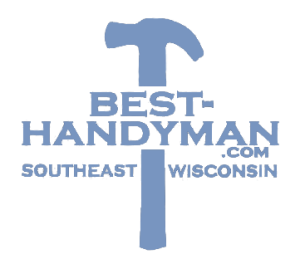Drywall Installation & Repair | Milwaukee & Wauwatosa
At Best Handyman, our experienced handymen are here to help with your drywall needs. Whether your walls are damaged, or you just want to finish a room with beautiful new drywall, we are your go-to drywall experts in the Wauwatosa and Milwaukee area.
 Drywall Installation and Repair FAQs and Considerations
Drywall Installation and Repair FAQs and Considerations
What is drywall?
Sometimes called wall board, gypsum board, plasterboard, or sheetrock, drywall is a lightweight and cost-effective material used to construct interior walls and ceilings. Drywall is made from calcium sulfate digydrate, or “gypsum,” sandwiched between a thick type of paper. The result is a firm, lightweight board material ideal for interior walls and ceilings.
Drywall can be used in new construction, reconstruction of older homes, and in repair work. While it is a relatively easy material to work with, most people would do best in hiring a professional to install or repair drywall in their home.
Are there different types of drywall?
Yes. Drywall can vary based on it’s features (mold-resistant, fire-resistant, water-resistant), sheet size, thickness, treatment, and edges (square or tapered). Which variety you choose will depend on your needs, goals, and the look you are going for.
How is drywall installed?
Since drywall comes in large sheets, an expert drywall installer will first carefully measure and cut the drywall material to fit the specifications of the space. They then prepare corners and spaces where drywall will end by fastening wood backing so the drywall can easily be screwed into place. They then hang the drywall, ensuring the surface is smooth and the seams come together. Finally, they tape and sand the joints and cover the screw heads to create a flawless surface for paint or other finishes.
Can I install drywall myself?
While you can install drywall yourself, we strongly suggest hiring an expert (like those at Best Handyman!). Hanging drywall can be heavy work, and usually requires a lot of dexterity. Since drywall is often a highly visible element of your home (in its function as interior walls and ceilings), you can’t go wrong trusting an expert to hang and install the drywall properly so it looks flawless and is ready for paint.
Will drywall installation create a lot of dust?
One of the few challenges of drywall installation is managing dust. Cutting and installing drywall actually does not create a ton of dust, but sanding and finishing the drywall once it has been hung does. At Best Handyman, we do our “best” to keep dust to a minimum, and can give you tips for how to prevent dust accumulation and damage.
How long does it take to install drywall?
That depends on the size of the project. The good thing about drywall is that it doesn’t need any extra time to dry, which was a hassle with plaster, a material traditionally used to build walls and ceilings pre-drywall. Our expert installers provide efficiency without sacrificing detail or quality. Give us a call today to discuss your specific needs, and we can give you an estimate on how long it will take to complete your drywall project.
My home has mold and mildew problems. Can new drywall help?
Depending on the room in the home, it may be necessary to remove and replace drywall if it has accumulated mold and mildew. If exposure to large amounts of water (such as a flood or rain leak) has happened very recently, a drywall expert may be able to restore the drywall without replacing it.
Due to its porousness, drywall can be particularly susceptible to moisture, which is why moisture-resistant drywall varieties are a good idea if you live in a humid climate. In rooms that tend to have high humidity, like the kitchen, bathroom, and laundry room, it is advisable to use a different material – like cement board or green board – for walls and ceilings instead of drywall.
How much does it cost to install drywall near me?
Each project is different, and the cost of a drywall installation project with Best Handyman depends on a number of factors. What we can tell you is that we provide excellent service at a great value. Give us a call today to discuss your current situation and schedule a time for us to come and give you a FREE estimate.
Do I need to be home during this project?
Yes. Not only do we need someone to let us in the home, but we may have questions during the installation that only you can answer. Also, we can offer helpful maintenance tips while we are there, and answer questions you may have about the project. We are happy to speak with you to find a time that works with your schedule. Give us a call today!
Why should I hire Best Handyman for my drywall project?
We may be biased, but when you choose Best Handyman for your drywall installation or repair project, we know you will get the best work for the best value. We have more than 20 years of experience providing handiwork services to homes in Wisconsin, offer a 1-year guarantee on all labor, and are proudly to be locally owned. But don’t just take it from us – give us a call to schedule your appointment today!
DIY Directions: How To Patch a Hole in Your Drywall
Patching a hole in your drywall or plaster doesn’t have to be a major project. First determine how bad and big the hole is. For instance, a doorknob that accidentally got slammed into the wall and made a 4”x4” hole is fixed pretty much the same as a 24”x24” hole.
The first thing you need to do is put down a tarp or blanket to catch the drywall dust and scrap you’re going to make. Next if you have a straight edge or a carpenters square, make a square or rectangle with a pencil to the outer most damaged drywall. Then use a razor knife to score and cut the line you just made, and carefully remove the drywall.
The next thing you need to do is cut a piece of 1×2 or 1×4 the length of the inside of the hole you just made and screw the pieces on the inside of the wall to the drywall for reinforcement. Be sure to countersink your screws and do at least 2 sides. Then carefully cut a piece of drywall to fit into the opening and rest on your reinforced wood. Be sure to use ½” drywall even if the wall is thicker. Next you will need a small bag of 5 or 20-minute drywall mud. Mix up enough to cover your seams and screw holes and spread with a 3” or 6” putty knife. Let dry then carefully sand. Then use 90-minute mudd, and repeat the process, sanding in between.
Once everything is smooth and looking the way you want it, paint with a primer, with sand in it, and paint the patch to match the rest of the wall. The process is the same for plaster except if you have the lathes still there; you will only need to mudd the lathes, and no need for a drywall patch.
